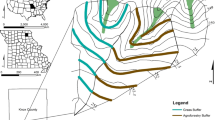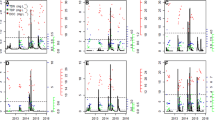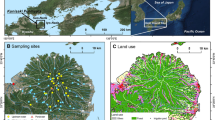Abstract
Dissolved organic carbon (DOC) constitutes a small yet important part of a watershed’s carbon budget because it is mobile and biologically active. Agricultural conservation practices such as native perennial vegetation (NPV) strips will influence carbon cycling of an upland agroecosystem, and could affect how much DOC enters streams in runoff, potentially affecting aquatic ecosystems. In a study conducted in Iowa (USA), four treatments with strips of NPV varying in slope position and proportion of area were randomly assigned among 12 small agricultural watersheds in a balanced incomplete block design. Runoff samples from 2008 to 2010 were analyzed for DOC and correlated with flow data to determine flow weighted DOC concentrations and loads. Data were analyzed for the entire 3 years, annually, seasonally, monthly, by flow event size and for one extreme storm event. Overall we found few differences in DOC concentration with the exception that concentrations were greater in the 10 % NPV at the footslope watersheds than the 20 % NPV in contours watersheds over the 3 years, and the 100 % agricultural treatment had higher DOC concentrations than all NPV treatments during the one extreme event. Because the NPV treatments reduced runoff, DOC export tended to be highest in the 100 % agricultural watersheds over the 3 years and during high flows. We also compared two watersheds that were restored to 100 % NPV and found decreases in DOC concentrations and loads indicating that complete conversion to prairie leads to less watershed DOC export. Regression results also support the contention that increases in the percentage of NPV in the watershed decreases watershed export of DOC. Further analysis indicated that DOC concentrations were diluted as flow event size increased, independent of any treatment effects. It appears groundwater sources become an important component to flow as flow event size increases in these watersheds.

Similar content being viewed by others
References
Agren A, Jansson M, Ivarsson H, Bishop K, Seibert J (2008) Seasonal and runoff related changes in total organic carbon concentrations in the River Ore, northern Sweden. Aquat Sci 70:21–29
Avalos JMM, Fouz PS, Vazquez EV, Gonzalez AP, Bertol I (2009) Crop residue effects on organic carbon, nitrogen, and phosphorus concentrations and loads in runoff water. Commun Soil Sci Plant Anal 40:200–213
Borin M, Passoni M, Thiene M, Tempesta T (2010) Multiple functions of buffer strips in farming areas. Eur J Agron 32:103–111
Brye KR, Norman JM, Bundy LG, Gower ST (2001) Nitrogen and carbon leaching in agroecosystems and their role in denitrification potential. J Environ Qual 30:58–70
Brye KR, Gower ST, Norman JM, Bundy LG (2002) Carbon budgets for a prairie and agroecosystems: effects of land use and interannual variability. Ecol Appl 12(4):962–979
Chantigny MH (2003) Dissolved and water-extractable organic matter in soils: a review on the influence of land use and management practices. Geoderma 113:357–380
Dalzell BJ, Filley TR, Harbor JM (2005) Flood pulse influences on terrestrial organic matter export from an agricultural watershed. J Geophys Res 110:G02011
Dalzell BJ, Filley TR, Harbor JM (2007) The role of hydrology in annual organic carbon loads and terrestrial organic matter export from a midwestern agricultural watershed. Geochim Cosmochim Acta 71:1448–1462
Dalzell BJ, King JY, Mulla DJ, Finlay JC, Sands GR (2011) Influence of subsurface drainage on quantity and quality of dissolved organic matter export from agricultural landscapes. J Geophys Res Biogeosci 116:G02023
Dittman JA, Shanley JB, Driscoll CT, Aiken GR, Chalmers AT, Towse JE (2009) Ultraviolet absorbance as a proxy for total dissolved mercury in streams. Environ Pollut 157:1953–1956
Eichmiller JJ (2007) Supply, bioavailability, and source of dissolved organic carbon in a prairie stream. M.S. thesis. Kansas State University, Manhattan, KS, p 87
Frank H, Patrick S, Peter W, Hannes F (2000) Export of dissolved organic carbon and nitrogen from Gleysol dominated catchments—the significance of water flow paths. Biogeochemistry 50:137–161
Helmers MJ, Zhou X, Asbjornsen H, Kolka R, Tomer MD, Cruse RM (2012) Sediment removal by perennial filter strips in row-cropped ephemeral watersheds. J Environ Qual 41(5):1531–1539
Hernandez-Santana V, Zhou X, Helmers MJ, Asbjornsen H, Kolka R, Tomer MD (2013) Native prairie filter strips reduce runoff from hillslopes under annual row-crop systems in Iowa, USA. J Hydrol 477:94–103
Inamdar SP, Christopher SF, Mitchell MJ (2004) Export mechanisms for dissolved organic carbon and nitrate during summer storm events in a glaciated forested catchment in New York, USA. Hydrol Process 18:2261–2651
Jacinthe PA, Lal R, Owens LB, Hothem DL (2004) Transport of labile carbon in runoff as affected by land use and rainfall characteristics. Soil Tillage Res 77:111–123
Johnson LT, Tank JL, Arango CP (2009) The effect of land use on dissolved organic carbon and nitrogen uptake in streams. Freshw Biol 54:2335–2350
Mailapalli DR, Wallender WW, Burger M, Horwath WR (2010) Effects of field length and management practices on dissolved organic carbon export in furrow irrigation. Agric Water Manag 98:29–37
McDowell WH, Likens GE (1998) Origin, composition, and flux of dissolved organic carbon in the Hubbard Brook valley. Ecol Monogr 58(3):177–195
Raymond PA, Saiers JE (2010) Event controlled DOC export from forested watersheds. Biogeochemistry 100:197–209
Royer TV, David MB (2005) Export of dissolved organic carbon from agricultural streams in Illinois, USA. Aquat Sci 67:465–471
Royer I, Angers DA, Chantigny MH, Simard RR, Cluis D (2007) Dissolved organic carbon in runoff and tile-drain water under corn and forage fertilized with hog manure. J Environ Qual 36:855–863
Sanderman J, Amundson R (2009) A comparative study of dissolved organic carbon transport and stabilization in California forest and grassland soils. Biogeochemistry 92:41–59
Schilling KE, Tomer MD, Zhang YK, Weisbrod T, Jacobson P, Cambardella CA (2007) Hydrogeologic controls on nitrate transport in a small agricultural catchment, Iowa. J Geophys Res 112:G03007
Schmitt TJ, Dosskey MG, Hoagland KD (1999) Filter strip performance and processes for different vegetation, width, and contaminants. J Environ Qual 28:1479–1489
Stanley EH, Powers SM, Lottig NR, Buffam I, Crawford JT (2012) Contemporary changes in dissolved organic carbon (DOC) in human-dominated rivers: is there a role for DOC management? Freshw Biol 57(Suppl. 1):26–42
Stedmon CA, Markager S, Sondergaard M, Vang T, Laubel A, Borch NH, Windelin A (2006) Dissolved organic matter (DOM) export to a temperate estuary: seasonal variations and implications of land use. Estuaries Coasts 29:388–400
Tomer MD, Meek DW, Jaynes DB, Hatfield J (2003) Evaluation of nitrate nitrogen fluxes from a tile drained watershed in central Iowa. J Environ Qual 32:642–653
Tomer MD, Schilling KE, Cambardella CA, Jacobson P, Drobney P (2010) Groundwater nutrient concentrations during prairie reconstruction on an Iowa landscape. Agric Ecosyst Environ 139:206–213
Udawatta RP, Henderson GS, Jones JR, Hammer RD (2006) Runoff and sediment from row-crop, row-crop with grass strips, pasture, and forest watersheds. Revue des Sciences de l’Eau 19:137–149
Veum KS, Goyne KW, Motavalli PP, Udawatta RP (2009) Runoff and dissolved organic carbon loss from a paired-watershed study of three adjacent agricultural watersheds. Agric Ecosyst Environ 130:115–122
Vidon P, Wagner LE, Soyeux E (2008) Changes in the character of dissolved organic carbon in streams during storms in two Midwestern watersheds with contrasting land uses. Biogeochemistry 88:257–270
Warrner TJ, Royer TV, Tank JL, Griffiths NA, Rosi-Marshall EJ, Whiles MR (2009) Dissolved organic carbon in streams from artificially drained and intensively farmed watersheds in Indiana, USA. Biogeochemistry 95:295–307
Wilson HF, Xenopoulos MA (2009) Effects of agricultural land use on the composition of fluvial dissolved organic matter. Nat Geosci. doi:10.1038/NGEO391
Xenopoulos MA, Schindler DW (2001) Physical factors determining ultraviolet radiation flux in ecosystems. In: Cockell CS, Blaustein AR (eds) Ecosystems, evolution and ultraviolet radiation. Springer, New York, pp 36–62
Zhou X, Helmers MJ, Asbjornsen H, Kolka R, Tomer MD (2010) Perennial filter strips reduce nitrate levels in soil and shallow groundwater after grassland-to-cropland conversion. J Environ Qual 39:2006–2015
Zhou X, Helmers MJ, Asbjornsen H, Kolka R, Tomer MD, Cruse R (2014) Nutrient removal by prairie filter strips in agricultural landscapes. J Soil Water Conserv 69(1):54–64
Author information
Authors and Affiliations
Corresponding author
Additional information
Responsible Editor: Stephen Porder
Rights and permissions
About this article
Cite this article
Smith, T.E., Kolka, R.K., Zhou, X. et al. Effects of native perennial vegetation buffer strips on dissolved organic carbon in surface runoff from an agricultural landscape. Biogeochemistry 120, 121–132 (2014). https://doi.org/10.1007/s10533-014-9985-y
Received:
Accepted:
Published:
Issue Date:
DOI: https://doi.org/10.1007/s10533-014-9985-y




